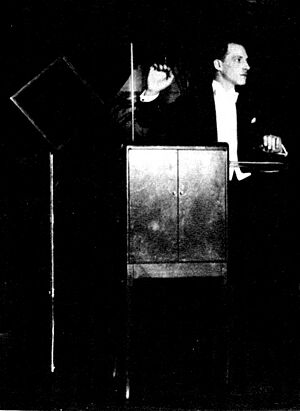Léon Theremin facts for kids
Léon Theremin (born Lev Sergeyevich Termen) (August 15, 1896 – November 3, 1993) was a Russian inventor. He is most famous for inventing the theremin. This was one of the very first electronic musical instruments.
Léon Theremin was born in Saint Petersburg, Russia. His family had French ancestors.
Contents
Biography of Léon Theremin
Early Inventions
Léon Theremin invented the theremin (also called the thereminvox) in 1919. At this time, his country was in the middle of the Russian Civil War. He also invented the first electronic burglar alarm. He called this alarm a "radio watchman."
Moving to the United States
Theremin moved to the United States on December 30, 1927. He came with his first wife, Katia Constantinova. In 1928, he played the theremin with the New York Philharmonic orchestra.
He got a patent for his invention in the United States in 1928. A patent gives an inventor the right to stop others from making, using, or selling their invention for a certain time. After this, he allowed RCA to produce his invention for sale.
In the 1930s, Theremin opened a laboratory in New York. There, he worked on improving the theremin. He also experimented with other electronic musical instruments and new inventions.
Theremin was very interested in how the theremin could be used in dance music. He created special performance spaces. These spaces could react to dancers' movements with different sounds and lights. He even worked with the American Negro Ballet.
Later, Theremin fell in love with and married a young ballerina named Lavinia Williams. His marriage to an African-American dancer caused some surprise in his social groups. However, the couple stayed together.
Returning to the Soviet Union
Theremin suddenly went back to the Soviet Union in 1938. At the time, no one was sure why he returned. Some people thought he missed his home. Others believed that Soviet officials had taken him against his will. His wife, Lavinia, told a friend that "some Russians had come in" and taken him from his studio.
In the Soviet Union, Theremin was made to work in secret research and development laboratories. These were part of the Gulag labor camp system. The Gulag was a system of forced labor camps.
While there, Theremin created a listening system called "Buran." This system could record conversations in embassies. It worked by measuring tiny vibrations in window glass using an infrared beam. Lavrenty Beria, who was the head of the KGB, used Buran to spy on the US, British, and French embassies. The KGB was the main security agency of the Soviet Union.
In 1945, Theremin invented the first covert listening device, also known as a "bug." This device was hidden inside a carved wooden plaque of the Great Seal of the United States. On August 4, 1945, Soviet schoolchildren gave this bugged carving to the U.S. Ambassador, W. Averell Harriman. It was presented as a "gesture of friendship" to the USSR's World War II ally.
The carving hung in the ambassador’s office in Moscow until 1952. That's when a British radio operator found the bug. He heard conversations on an open radio channel. The CIA later found the device inside the Great Seal carving. A scientist named Peter Wright eventually figured out how the device worked.
Later Life and Travels
After being released from the labor camp in 1947, Theremin chose to keep working with the KGB until 1966. By 1947, Theremin had married again to Maria. They had two children, Lena and Natalia.
After working for the KGB, Theremin taught at the Moscow Conservatory of Music for 10 years. He also built more Theremins, electronic cellos, and some Terpsitones.
A reporter from The New York Times discovered him there. When an article about him appeared, the Vice President of the conservatory was angry. He said, "The people don't need electronic music. Electricity is for killing traitors in the electric chair." Theremin was fired, his laboratory was closed, and his instruments were destroyed.
After 51 years in the Soviet Union, Léon Theremin started traveling again. He visited France in June 1989. Then, in 1991, he traveled to the United States. His daughter Natalia went with him on both trips. In the US, he met Clara Rockmore again. She performed several concerts at this time. He also gave a demonstration concert in The Hague in early 1993. Léon Theremin died in Moscow in 1993 at the age of 97.
Documentary Film
Léon Theremin is the main subject of a documentary movie called Theremin: An Electronic Odyssey. Steven M. Martin wrote, directed, and produced this film. The documentary won an award at the Sundance Film Festival in 1994.
The movie features famous theremin players like Clara Rockmore and Lydia Kavina. It also includes electronic instrument pioneer Robert Moog. Other people in the film are Nicolas Slonimsky and The Beach Boys founder Brian Wilson. Theremin himself also appears in the movie.
- from The History Channel
Images for kids
See also
 In Spanish: León Teremin para niños
In Spanish: León Teremin para niños




